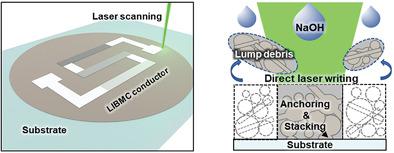Our official English website, www.x-mol.net, welcomes your feedback! (Note: you will need to create a separate account there.)
Monolithically Programmed Stretchable Conductor by Laser-Induced Entanglement of Liquid Metal and Metallic Nanowire Backbone
Small ( IF 13.3 ) Pub Date : 2022-07-28 , DOI: 10.1002/smll.202202841 Chulmin Cho 1, 2 , Wooseop Shin 1 , Minwoo Kim 1 , Junhyuk Bang 1 , Phillip Won 3 , Sukjoon Hong 4 , Seung Hwan Ko 1, 5
Small ( IF 13.3 ) Pub Date : 2022-07-28 , DOI: 10.1002/smll.202202841 Chulmin Cho 1, 2 , Wooseop Shin 1 , Minwoo Kim 1 , Junhyuk Bang 1 , Phillip Won 3 , Sukjoon Hong 4 , Seung Hwan Ko 1, 5
Affiliation

|
Owing to its low mechanical compliance, liquid metal is intrinsically suitable for stretchable electronics and future wearable devices. However, its invariable strain-resistance behavior according to the strain-induced geometrical deformation and the difficulty of circuit patterning limit the extensive use of liquid metal, especially for strain-insensitive wiring purposes. To overcome these limitations, herein, novel liquid-metal-based electrodes of fragmented eutectic gallium-indium alloy (EGaIn) and Ag nanowire (NW) backbone of which their entanglement is controlled by the laser-induced photothermal reaction to enable immediate and direct patterning of the stretchable electrode with spatially programmed strain-resistance characteristics are developed. The coexistence of fragmented EGaIn and AgNW backbone, that is, a biphasic metallic composite (BMC), primarily supports the uniform and durable formation of target layers on stretchable substrates. The laser-induced photothermal reaction not only promotes the adhesion between the BMC layer and substrates but also alters the structure of laser-irradiated BMC. By controlling the degree of entanglement between fragmented EGaIn and AgNW, the initial conductivity and local gauge factor are regulated and the electrode becomes effectively insensitive to applied strain. As the configuration developed in this study is compatible with both regimes of electrodes, it can open new routes for the rapid creation of complex stretchable circuitry through a single process.
中文翻译:

液态金属和金属纳米线主干的激光诱导纠缠单片编程可拉伸导体
由于其低机械柔顺性,液态金属本质上适用于可拉伸电子产品和未来的可穿戴设备。然而,根据应变引起的几何变形和电路图案化的难度,其不变的应变电阻行为限制了液态金属的广泛使用,特别是用于应变不敏感布线目的。为了克服这些限制,本文提出了一种新型液态金属基电极,由碎片共晶镓铟合金 (EGaIn) 和 Ag 纳米线 (NW) 主链组成,其纠缠由激光诱导的光热反应控制,以实现立即和直接图案化开发了具有空间编程应变电阻特性的可拉伸电极。碎片化的 EGaIn 和 AgNW 主干共存,即 一种双相金属复合材料 (BMC),主要支持在可拉伸基材上均匀且持久地形成目标层。激光诱导的光热反应不仅促进了 BMC 层和基板之间的粘附,而且改变了激光照射 BMC 的结构。通过控制碎片化 EGaIn 和 AgNW 之间的纠缠程度,可以调节初始电导率和局部应变系数,并且电极对施加的应变有效地变得不敏感。由于本研究中开发的配置与两种电极方案兼容,它可以为通过单一过程快速创建复杂的可拉伸电路开辟新途径。激光诱导的光热反应不仅促进了 BMC 层和基板之间的粘附,而且改变了激光照射 BMC 的结构。通过控制碎片化 EGaIn 和 AgNW 之间的纠缠程度,可以调节初始电导率和局部应变系数,并且电极对施加的应变有效地变得不敏感。由于本研究中开发的配置与两种电极方案兼容,它可以为通过单一过程快速创建复杂的可拉伸电路开辟新途径。激光诱导的光热反应不仅促进了 BMC 层和基板之间的粘附,而且改变了激光照射 BMC 的结构。通过控制碎片化 EGaIn 和 AgNW 之间的纠缠程度,可以调节初始电导率和局部应变系数,并且电极对施加的应变有效地变得不敏感。由于本研究中开发的配置与两种电极方案兼容,它可以为通过单一过程快速创建复杂的可拉伸电路开辟新途径。初始电导率和局部应变系数受到调节,电极变得对施加的应变有效不敏感。由于本研究中开发的配置与两种电极方案兼容,它可以为通过单一过程快速创建复杂的可拉伸电路开辟新途径。初始电导率和局部应变系数受到调节,电极变得对施加的应变有效不敏感。由于本研究中开发的配置与两种电极方案兼容,它可以为通过单一过程快速创建复杂的可拉伸电路开辟新途径。
更新日期:2022-07-28
中文翻译:

液态金属和金属纳米线主干的激光诱导纠缠单片编程可拉伸导体
由于其低机械柔顺性,液态金属本质上适用于可拉伸电子产品和未来的可穿戴设备。然而,根据应变引起的几何变形和电路图案化的难度,其不变的应变电阻行为限制了液态金属的广泛使用,特别是用于应变不敏感布线目的。为了克服这些限制,本文提出了一种新型液态金属基电极,由碎片共晶镓铟合金 (EGaIn) 和 Ag 纳米线 (NW) 主链组成,其纠缠由激光诱导的光热反应控制,以实现立即和直接图案化开发了具有空间编程应变电阻特性的可拉伸电极。碎片化的 EGaIn 和 AgNW 主干共存,即 一种双相金属复合材料 (BMC),主要支持在可拉伸基材上均匀且持久地形成目标层。激光诱导的光热反应不仅促进了 BMC 层和基板之间的粘附,而且改变了激光照射 BMC 的结构。通过控制碎片化 EGaIn 和 AgNW 之间的纠缠程度,可以调节初始电导率和局部应变系数,并且电极对施加的应变有效地变得不敏感。由于本研究中开发的配置与两种电极方案兼容,它可以为通过单一过程快速创建复杂的可拉伸电路开辟新途径。激光诱导的光热反应不仅促进了 BMC 层和基板之间的粘附,而且改变了激光照射 BMC 的结构。通过控制碎片化 EGaIn 和 AgNW 之间的纠缠程度,可以调节初始电导率和局部应变系数,并且电极对施加的应变有效地变得不敏感。由于本研究中开发的配置与两种电极方案兼容,它可以为通过单一过程快速创建复杂的可拉伸电路开辟新途径。激光诱导的光热反应不仅促进了 BMC 层和基板之间的粘附,而且改变了激光照射 BMC 的结构。通过控制碎片化 EGaIn 和 AgNW 之间的纠缠程度,可以调节初始电导率和局部应变系数,并且电极对施加的应变有效地变得不敏感。由于本研究中开发的配置与两种电极方案兼容,它可以为通过单一过程快速创建复杂的可拉伸电路开辟新途径。初始电导率和局部应变系数受到调节,电极变得对施加的应变有效不敏感。由于本研究中开发的配置与两种电极方案兼容,它可以为通过单一过程快速创建复杂的可拉伸电路开辟新途径。初始电导率和局部应变系数受到调节,电极变得对施加的应变有效不敏感。由于本研究中开发的配置与两种电极方案兼容,它可以为通过单一过程快速创建复杂的可拉伸电路开辟新途径。


























 京公网安备 11010802027423号
京公网安备 11010802027423号